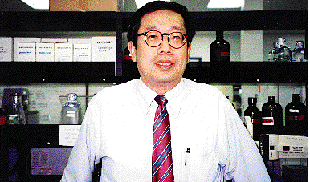GOLDSEA | ASIAMS.NET | ASIAN AMERICAN PERSONALITIES
DR DNA
PAGE 5 of 7
Fong developed a reputation as a fount of innovative research tools.
"I had a lot of people asking me for the research material that I created," he recalls. As was the custom in the academic research community, he gladly sent off his materials free of charge.
| "The net usually depends on how much you want to spend for tomorrow." |
"They wanted me because they were looking for someone who knew how to do recombinant DNA research," Fong recalls. "Some researchers were aspiring to learn new research techniques. They hire you and get it from you." At NIH Fong's research focused on the prostate hormone gene.
"Essentially we asked the question whether you can clone all the genes in the prostate and the testes to see how they affect metabolism in these organs. It was very basic research."
At NIH Fong again distinguished himself more for coming up with innovative research tools and methods than brilliance in conceiving groundbreaking experiments. "I could put things together and people would love to have me send it to them."
In late 1983 Fong decided the time had come to make use of his true gift. He decided to leave NIH and take a gamble with Clontech. Pam was highly supportive. She gave up an optometrist position in North Carolina to return to Northern California three months ahead of Fong to establish a steady income stream that could support themselves and their infant son Jon.
With no record of success in the business world, Fong decided it would be too difficult to find investors willing to provide the startup capital. Instead, he set his sights on the modest goal of developing a single product and turned to younger brother Danny whose small water analysis business was already established and profitable. Danny agreed to lend Fong $35,000 and the use of some laboratory space. Apparently, he had no interest in becoming an investor and Fong has long since repaid Danny "with a good amount of interest".
"He didn't know if we would be able to make it," Fong says, chuckling. "He had less faith in me than in his own business. He's doing very well. He probably makes more money than I do, maybe not in terms of total value, but he has very little overhead. It's a service with very high margins. If I work on a product, it could fail and lose a lot of money. But he has no new products to invest in."
Fong developed Clontech's first product in collaboration with a Stanford researcher named Richard Young. While still at NIH Fong had read an article about Young's system for screening for new genes. After moving to Palo Alto Fong called Young--a caucasian, as it turned out--and suggested they get together for coffee.

"I knew [Young's system] was good so I told him I'd like to further develop it and commercialize it. He liked the idea." Fong paid him a small up-front fee and royalties from sales. Young--now an MIT professor--did the development at his Stanford lab. This low-overhead strategy of outsourcing research and development proved to be effective and Clontech relies on it heavily to this day for access to a wide array of new technologies that can't be cultivated in a single laboratory. At the moment half of Clontech's new products are licensed from outside researchers.
"No company can have all their innovations in house," Fong says. "It's not only too expensive. Even if we had $20 billion, [one company] cannot manage $20 billion of research.
"My talent probably lies in knowing what's good and what's not," he adds. "I might not be able to do as well as these guys I pick but I know how to pick.
"This country is the best in terms of innovation. The government and other agencies spend close to $20 billion in biotech research and Clontech makes use of the innovation and translates it into products. We also make specific products by in-house research and development but we can't compete in all the areas of innovation out there."
Fong hired his first in-house employee in 1984 soon after starting up.
"I needed some help, at least to answer the phone." He placed a help wanted ad in a small local newspaper. It was answered by a young Indian American male named Vic Sharma who had graduated from Berkeley with a degree in biochemistry.
"The guy called me at nine o'clock and said, 'Can I come over at 10 o'clock?' He was dressed like he just got out of bed. I said, 'May I have your resume?' The resume was all wrinkled. I said, 'Vic, I think you have the qualifications but I can't pay you a good salary.' He said, 'How much can you pay?' 'The most we can do is $700 a month.' He looked at me, he had a strange look. PAGE 6
Page 1 |
2 |
3 |
4 |
5 |
6 |
7 |
CONTACT US
|
ADVERTISING INFO
© 1996-2013 Asian Media Group Inc
No part of the contents of this site may be reproduced without prior written permission.
